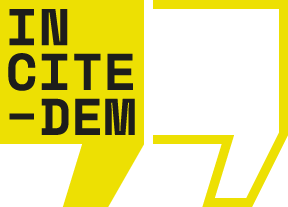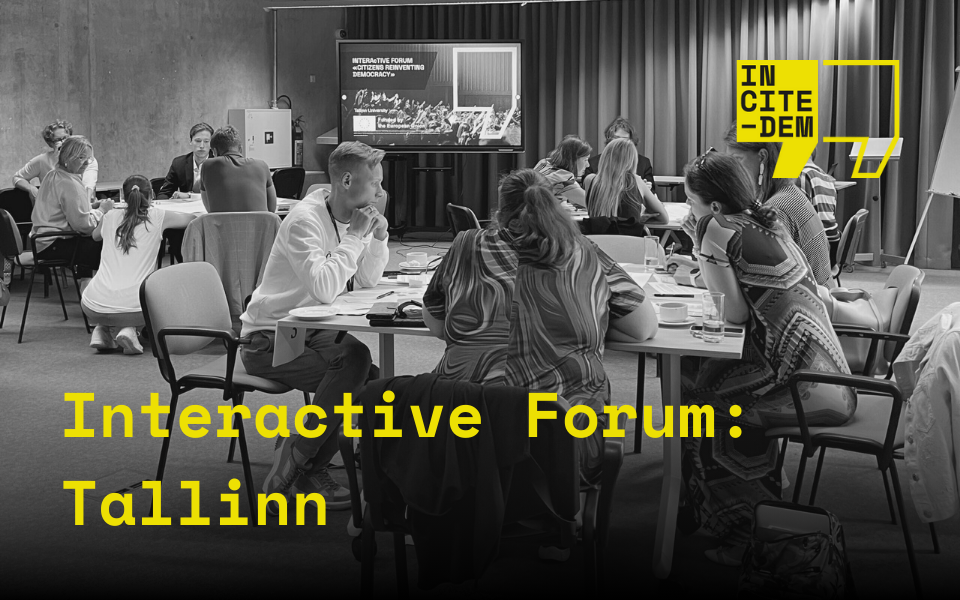On August 14th, Tallinn University hosted an Interactive Forum that gathered 14 participants from across Estonia’s political and civic landscape. The group included politicians from different local parties, NGO representatives working on citizen engagement, deputy mayors from two Tallinn districts, as well as officials from the Ministry of Education and Research, the Ministry of Interior Affairs, and the Government Office. The balance of voices — 7 women and 7 men of different ages—helped ensure a diverse exchange.
The forum was part of the INCITE-DEM project, which brings citizen-designed democratic innovations into dialogue with policymakers. Across Europe, six representative models for inclusive and participatory democracy have been developed from the Democracy Labs. The Tallinn session focused on assessing how these models could be adapted and implemented in the Estonian context.
Each group shared their insights in plenary discussions supported by specific activities, which brought forward both enthusiasm and critical reflection. The atmosphere was lively and constructive, showing that democratic innovations spark meaningful conversations when diverse institutional actors sit at the same table.

Key Takeaways from group discussions
The Tallinn Interactive Forum highlighted both the promise and the challenges of adapting citizen-driven democratic innovations to the Estonian context. Several cross-cutting insights emerged:
Digital participation is valued, but inclusion remains a challenge:
Participants welcomed the transparency and accessibility that digital platforms can bring—the digital aspect was mentioned in several models. Yet concerns were raised about how to reach older citizens unfamiliar with digital tools, as well as data protection concerns and whether the digital tools can truly be transparent and unbiased (this is also a trust issue). Use of AI-based innovation for assisting with aggregating information, synthesising ideas, and helping people formulate good initiatives was seen as important.
Structures and incentives matter:
Across models, questions arose about sustainability: How should participants be selected? Should involvement be voluntary or compensated? Without clear standards, groups might vary in activity and effectiveness. Some suggested the paid “free day” or democracy allowance could be an option to incentivise people and free up their time, although it would require strong political will and ample resources, while others noted that clear rules for meeting frequency and responsibilities are essential.
Education is key to long-term impact:
The idea of introducing “democracy labs” in schools resonated strongly, but as a specifically educational initiative connected clearly to curriculum. Participants saw early civic education as a way to nurture future generations of active citizens who understand deliberation, compromise, and participation as everyday practices.
Balancing representation with expertise:
Random selection was valued for ensuring diversity across age, gender, and background. However, participants stressed the importance of integrating expert knowledge—whether legal advice or scientific input—to ensure that citizen proposals are feasible and informed. They also were challenged by the idea of everyone’s voice being equal (not everyone’s voice should be equal due to lack of expertise and commitment to specific issues) and also how the citizen assemblies and consultation groups could meaningfully be aligned with representative democracy.
Resources and feasibility remain key open questions:
While some models inspired enthusiasm, practical concerns persisted: who funds and sustains new community houses, assemblies, or even a national “civic engagement day”? For example, the proposal of a weekly paid volunteer day raised excitement but also questions about costs and potential misuse. It seemed most models expected the government (taxpayer) to pay, but national budgets are struggling to even cover essential costs, inflation is rising and so forth. Many initiatives proposed childcare, elderly care, legal advice, etc., with almost 24/7 access—this is clearly not feasible, especially in smaller municipalities.
Potential to strengthen trust and community:
Despite uncertainties, participants agreed that the presented innovations could deepen trust in institutions, counter misinformation (although in some cases also promote it), and foster stronger community bonds. Examples such as the Kalamaja Museum, which already serves as a community hub in Tallinn, showed how existing spaces could be leveraged to host dialogue and collective action.

Overall Impressions from the Interactive Forum in Estonia
In the case of Estonia, all models received ample criticism alongside positive comments. Group members sometimes expressed very different views—one presenter even highlighted this diversity as a positive phenomenon. Despite the differences, the groups generally managed to formulate joint ideas and comments that most participants could support.
A recurring theme across all models was funding and feasibility: “Who is going to fund this? Where is the money coming from? This takes a lot of resources! Maybe it could work in a big town but not in a small municipality.”
Participants also raised concerns about how the models would align with existing representative democracy and ongoing initiatives. For example, Democracy Laboratories could perhaps be reframed as learning activities integrated into school curricula, in collaboration with libraries, which in Estonia already serve as community hubs hosting dialogues. Similarly, the participation app was seen as promising, but questions remained about integration with existing systems and whether municipalities would be able to use it effectively to engage citizens.
Overall, participants agreed that while all models have potential, they need much more critical evaluation and redesign in light of local contexts. This includes stronger links to existing democratic structures, careful consideration of inclusion and accessibility, and realistic planning for implementation.
As for general feedback on the forum itself, participants were positive and appreciated the discussions, noting that their expectations were largely met. One participant had hoped for more “innovation,” while another raised a provocative question about the feasibility of democracy itself—“should we have it at all?”—though, as others noted, the alternatives remain unclear.
In sum, the discussions showed that democratic innovations can inspire, but they must be adapted to local realities. Clearer structures, attention to inclusivity, and sustainable resourcing will be essential if these models are to move from inspiring concepts to everyday democratic practice.


